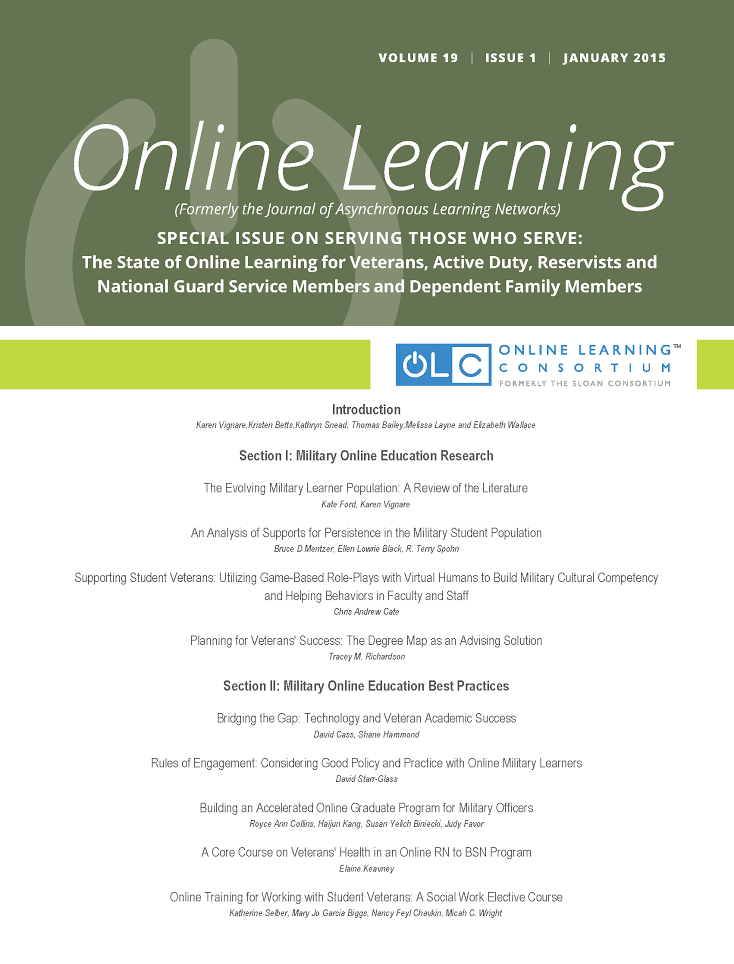Building an Accelerated Online Graduate Program for Military Officers
DOI:
https://doi.org/10.24059/olj.v19i1.497Keywords:
Accelerated program, military student, onlineAbstract
Because of the intense and unique nature of their military life, military officers face challenges that other students do not need to be concerned about when taking courses online. An institution's ability to understand these military officer students, design online programs to meet their unique learning needs, and deliver valuable online curriculum to advance their learning is instrumental to the long-term success of both the military student and the institution. Reflecting on our more than twenty years of experience teaching and mentoring military officer students, this article tells the story behind the development of an accelerated online program and shares the challenges brought along with having military officers in our online classes, including unpredictable deployment schedules, unannounced military exercises, security concerns, and military values and culture. How our faculty creatively and pedagogically addressed these challenges while still maintaining the rigor of our academic program is also discussed.References
Artino, A.R. (2009). Think, feel, act: Motivational and emotional influences on military students’ online academic success. Journal of Computing in Higher Education, 21(2), 146-166.
Barkley, E. (2009). Student engagement techniques: A handbook for college faculty. San Francisco, CA: Jossey-Bass.
Brown P. A. & Gross, C. (2011). Serving those who have served – managing veteran and military student best practices. The Journal of Continuing Higher Education, 59, 45-49.
Christen, S., Fall, L.T., & Kelly, S. (2011). Revisiting the impact of instructional immediacy: A differentiation between military and civilians. Quarterly Review of Distance Education, 12(3), 199-206.
Hamrick, F., Rumman, C. & Associates (2013). Called to serve: A handbook on student veterans and higher education. San Francisco: Jossey Bass.
Lehman, R. M., & Conceição, S. C. (2010). Creating a sense of presence in online teaching: How to ‘Be There’ for distance learners. San Francisco: Jossey-Bass.
Moore, M. G. (1980). Independent study. In R. D. Boyd, J. W. Apps, & Associates (Eds.), Redefining the discipline of adult education (Vol. 5, pp. 16-31). San Francisco: Jossey-Bass.
Moore, M. G. (1993). Theory of transactional distance. In D. Keegan (Ed.), Theoretical principles of distance education (Vol. 1, pp. 22-38). New York: Routledge.
Moore, M. & Kearsley, G. (2005). Distance education: A systems view (2nd ed.). Belmont, CA:Thomson Wadsworth.
Radford, A. W. & Weko, T. (2011). Military service members and veterans: A profile of those enrolled in undergraduate and graduate education in 2007-08 (Contract No. ED-07-CO-0104). National Center for Education Statistics: U.S. Department of Education.
Sadera, W. A., Robertson, J., Song, L., & Midon, M. M. (2009). The role of community in online learning success. Journal of Online Learning and Teaching, 5(2), 277-284.
Shearer, R. L. (2009). Transactional distance and dialogue :An exploratory study to refine the theoretical construct of dialogue in online learning. Unpublished Dissertation, The Pennsylvania State University, University Park.
Song, L., Singleton, E.S., Hill, J. R., & Koh, M. H. (2004). Improving online learning: Student perceptions of useful and challenging characteristics. Internet and Higher Education, 7(1), 59-70.
Smucny, D. & Stover, M. (2013). Enhancing teaching and learning for active-duty military students. ASA Footnotes, 41(3), 1-8. Retrieved from http://www.asanet.org/footnotes/marchapril13/military0313.html.
Starr-Glass, D. (2011). Military learners: Experience in the design and management of online learning environments. MERLOT Journal of Online Learning and Teaching, 7(1), 147-158.
Starr-Glass, D. (2013). Experiences with military online learners: Toward a mindful practice. MERLOT Journal of Online Learning and Teaching, 9(3). Retrieved from http://jolt.merlot.org/vol9no3/starr-glass_0913.htm
Sue, D.W. (2010). Microaggressions in everyday life: Race, gender, and sexual orientation. Hoboken, NJ: Wiley & Sons.
Swan, K. (2002). Building learning communities in online courses: The importance of interaction. Education, Communication & Information, 2(1), 23-49.
Downloads
Published
Issue
Section
License
As a condition of publication, the author agrees to apply the Creative Commons – Attribution International 4.0 (CC-BY) License to OLJ articles. See: https://creativecommons.org/licenses/by/4.0/.
This licence allows anyone to reproduce OLJ articles at no cost and without further permission as long as they attribute the author and the journal. This permission includes printing, sharing and other forms of distribution.
Author(s) hold copyright in their work, and retain publishing rights without restrictions






